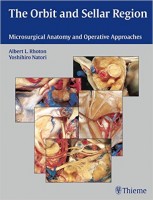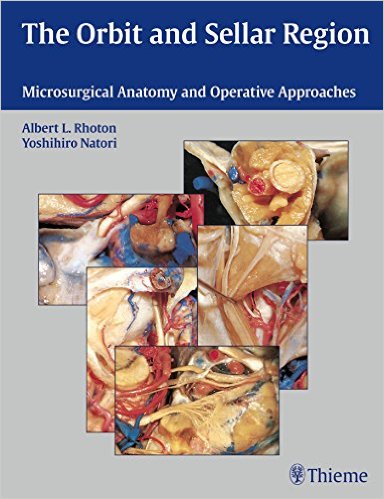 Authors: Albert L. Rhoton, Jr., MD; and Yoshihiro Natori, MD
Authors: Albert L. Rhoton, Jr., MD; and Yoshihiro Natori, MD
Publisher: Thieme – 311 pages
Book Review by: Nano Khilnani
This book addresses the increased need for clearer and more detailed understanding of the orbit region of the human head (around and behind the eyes) and its relationship to the sellar region located behind the orbit.
Surgeons are faced with treating an increasing number of cases of tumors and other lesions in these areas, as well as the surrounding intracranial and subcranial regions.
Near the orbit and sellar regions where better understanding of the anatomy, physiology and relationships is required for successful treatment of conditions and diseases, as well as better surgical outcomes, are these areas:
- The orbit and the anterior cranial fossa
- The orbit and middle fossa
- The orbit and the nasal cavity, including the paranasal sinuses
- The orbit and superior orbital fissure and cavernous sinus
- The orbit and other combinations of the structures
With this volume, the authors Drs. Albert Rhoton and Yoshihiro Natori aim to bring all of this anatomy into perspective. To this end, they have put together this text which contains 15 chapters in three parts we list below to give you a simple overview:
- Part I Anatomy (1)
- Chapter 1 Skull
- Chapter 2 Neural Structures
- Chapter 3 Arterial Structures
- Chapter 4 Venous Structures
- Chapter 5 Muscular Structures
- Part II Anatomy(2)
- Chapter 6 Superior View
- Chapter 7 Lateral View
- Chapter 8 Medial View
- Chapter 9 Inferior View
- Chapter 10 Anterior View
- Surgical Approaches
- Chapter 11 Orbitofrontal and Subfrontal Approaches
- Chapter 12 Orbitozygomatic and Frontotemporal Approaches
- Chapter 13 Lateral Approach
- Chapter 14 Inferior (Transmaxillary) Approach
- Chapter 15 Medial (Transethmoidal and Transspenoidal) Approaches
The layout of materials in each chapter is quite simple. A single, a clear, full-color photo, typically large and about a third to half the size of the page, is presented on each page. On the photo are labels of the anatomical parts shown. Below each photo are detailed explanations of what are shown in the photos and their interrelationships.
Some chapters have numerous photos, while others have a sparse number. The longest is chapter 2, Neural Structures, with about 50 pages. The shortest is chapter 14, Inferior (Transmaxillary) Approach, with 12 pages.
To give you a sort of rundown of the 50 anatomical photos and views from different sides in the chapter on Neural Structures, here is what you will find:
- 4 different photos of the anatomy surrounding the optic nerve: sagittal plane, superior aspect of the parasellar region and orbit, superior aspect of the right optic nerve, anterior superior view showing the relationship of the optic nerves to the sphenoid sinus.
- 8 different photos and views from different aspects of the oculomotor nerve.
- 2 different photos and views of the trocheal nerve
- 8 different photos and views of the ophthalmic nerve
- 1 photo of the ciliary ganglion
- 5 photos and views of the abducens (sometimes called abducent) nerve
- 1 photo of various nerves
- 1 photo of the ocular foramen
- 20 other photos and views of other nerves, ganglions, canals, etc.
This book provides to you very detailed information in text and full-color photos of the microsurgical anatomy of the orbit, sellar and surrounding regions: something you are highly unlikely to find in any other text. For this reason alone this is a very valuable resource, especially if you are an aspiring or practicing surgeon dealing with this area of the brain.
Editors:
Albert L. Rhoton, Jr., MD is R.D. Keene Family Professor of and Chairman of the Department of Neurosurgery in the College of Medicine at the University of Florida in Gainesville, Florida.
Yoshihiro Natori, MD, PhD is Associate Professor in the Department of Neurosurgery of the Neurological Institute at Kyushu University in Fukuoka, Japan.







